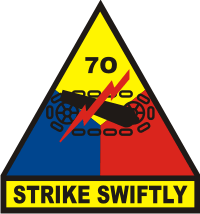From the 70th Armor Battalion history:
At 0630 on 6 June, 1944, after 18 months of training in secret, the 70th Tank Battalion rolled off of their landing crafts and onto Utah beach with the 4th Infantry Division. One of the first of the 70th Tank's soldiers to make it on the French shore was LT Franklin Anderson and his team of radiomen and engineers. Anderson was wounded by shrapnel after leaving the landing craft but made it to the seawall and directed the engineers as they blew holes in the wall for dozer tanks to enlarge.
Although A and B Companies were supposed to have been in the first wave, due to a mix up in the rendezvous area, the first tank on shore was commanded by PFC Owen Gavigan of C Company. C Company arrived with 12 of its 16 tanks and, under artillery and rocket fire, cleared obstacles with HE and bull dozer attachments and took key gun emplacements under fire, allowing follow-on ships filled with troops and supplies to make it to the beach. A Company was not so lucky. Before the tankers could disembark, one of the LCTs hit a mine and was blown in two. Nineteen tankers of the twenty on board died. As the rest of A Company's tanks hit the beach, they took up firing positions where they could support the infantry that were landing behind them. Two more tankers died during this operation, but the infantry landed safely.
70th Tank battalion engineers blew the seawall in front of B Company as their tanks hit the beach, but they met little resistance other than dismounted Germans exiting a bombed-out pillbox. All 16 of their tanks landed safely and moved through the breach made by the engineers and secured the causeway leading off the beach.
D Company, equipped with light tanks, was assigned the mission of linking up with the 101st Airborne Division which had landed behind the enemy defenses during the night. D Company found the infantry broken up into small groups under pressure from pockets of German resistance. By the end of the day, D Company had found large elements of the 101st and consolidated for the next morning's attack.
By nightfall, all the companies of the 70th Tank Battalion had reached their objectives and had consolidated the Utah beachhead.
The battalion fought its way north toward Cherbourg, at the head of the Cotentin Peninsula. C Company broke through to the 82nd Airborne at Ste. Mere Eglise on 8 June 1944, and the battalion continued north, cleaning up pockets of resistance along the road north. The tankers fought continuously for days on end, doggedly clearing the last German resistance. The town of Azeville fell on 11 June. Montebourg followed on 19 June. Cherbourg itself was not taken until 26 June, three weeks of exhaustive combat after the D-Day invasion.
The 70th Tank's losses during D-Day were the largest for any single day in the war. During the "Longest Day", they had lost 16 tanks, with 22 men killed and 8 wounded. By the time the Eighth Infantry Regiment had cleared the Cotentin Peninsula, the number of lost tanks had grown to 32, with 29 men KIA, 31 MIA and 48 WIA. The 70th Armor Battalion earned another Invasion Arrowhead and a Presidential Unit Citation for its critical role in the invasion of Normandy. 